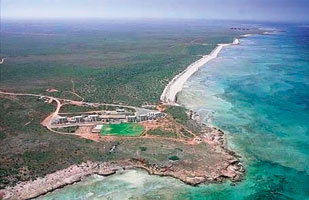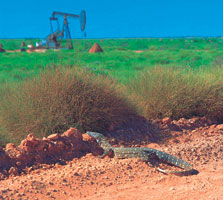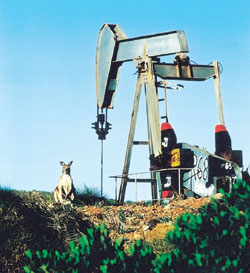Sustainable ecosystems: A critical step in sustainable development
Protecting the EnvironmentSustainable ecosystems: A critical step in sustainable developmentChevronTexaco’s Biodiversity Protection Program for Barrow Island has been a long term success in preserving a unique habitatRussell Lagdon, ChevronTexaco Australia Pty Ltd Thirty-five miles offshore Western Australia, Barrow Island’s isolation secured it as a habitat for a surprising variety of plants and animals; some are already extinct on the mainland, others are listed as rare and endangered. Studies of the island’s birds and mammals led to Barrow’s classification as an ‘A’ Class nature reserve in 1910, denoting its important status as a refuge for rare wildlife species. Such natural abundance flourishes in the presence of Australia’s second largest petroleum operation (Barrow Island oil field. ChevronTexaco is operator of the field and has partners Santos and ExxonMobil. The company’s disciplined use of environmental technology has created a showcase of sustainable development. This article describes this ongoing example of sustainable development. BACKGROUND By the time naturalist John T. Tunney arrived in 1900, Barrow Island was already more than 7,000 years old. Sparsely vegetated and arid, the island nonetheless exuded a natural beauty, Fig. 1. Rugged cliffs rose above blue tropical waters. Spectacular subsurface caves were lined with stalactites and stalagmites.
Today, the 90-sq-mi island is home to 227 species of native plants – including spinifex, the hardy, spiny-leafed grass that covers 90% of its surface – 14 mammal species, 110 types of birds and 54 species of reptile, including the giant Perentie, the world’s second largest lizard, Fig. 2. Eight species of rare marsupials are native to Barrow.
The first producing oilfield off Australia’s northwest coast, Barrow has yielded some 300 MMbbl of light sweet crude since its discovery in 1964. About 450 producing wells require continuous logistical support by barge (every two days) and plane (four times a week). In all, more than 10,000 cargo landings have been recorded since the field’s inception. Those shipments have included hundreds of thousands of separate items, each posing the risk of introducing non-native species and pests. Every container, section of pipe or piece of machinery could harbor a pregnant mouse, a rat or soil containing the seeds of invasive weeds, such as Kapok or Buffel Grass. Yet today, the island’s pristine ecosystem remains essentially intact. Barrow stands as Australia’s – and possibly the world’s – largest remaining land mass free of Black Rat infestation. ChevronTexaco’s operations are widely heralded as a model for the coexistence of petroleum development and the protection of biodiversity. Key to this success is the company’s approach to quarantine or, more precisely, quarantine management. MEETING THE CHALLENGE At Barrow, ChevronTexaco and its partners followed a disciplined environmental strategy from the start. In 1965 – two years before oil production began – noted Australian environmentalist Harry Butler crafted the Barrow Island Management Practices, subsequently adopted as an official part of Barrow’s operating manuals. Butler wrote that the company (then known as West Australian Petroleum Pty Ltd), “took immediate action to preserve the island’s wildlife values while developing its hydrocarbon resources.” Mammal monitoring of the island, most recently conducted in 2001 by ChevronTexaco and Australia’s Department of Conservation and Land Management (CALM), emphatically demonstrates the success of these efforts. Non-harmful spotlighting, trapping and tracking searches confirmed secure status on Barrow for the Burrowing Bettong, Golden Bandicoot, Spectacled Hare Wallaby and other mammal species, Fig. 3. No feral species were found.
The centerpiece of Barrow’s environmental policy is Quarantine Procedures, implemented since the beginning but substantially revised in 1994. Quarantine management is a "living" process, one that must be continually reviewed and modified to reduce the risk of exotic species disturbing Barrow’s sensitive ecosystem. These risks are not merely academic. The distribution and habitat of native flora and fauna on the mainland were severely impacted by European-introduced predators and agricultural practices. Habitats are in decline on other remote islands off Western Australia. Barrow’s burrowing Bettongs (a small marsupial), for example, are extinct on the nearby Montebello Islands. Bandicoots living on Barrow have disappeared from Dirk Hartog Island. And the Hare wallaby (that thrives on Barrow (is now extinct on both these other islands. In short, Barrow has become a reservoir for species that are endangered or extinct elsewhere. Since revising the Quarantine Procedures in 1994, only two instances of vermin arriving on Barrow Island have been recorded – two mice were found on a drilling rig in 1995, and a mouse was imported in a car wreck used for emergency training in 1998. In both cases, the Introduced Animal Contingency Plan, developed in consultation with CALM, was implemented and the pests were contained and exterminated. Supporting one of the most valuable mammal assemblages in Australia, Barrow is an example of a habitat not effected by sheep, cattle grazing or feral animals. Environmental management efforts continue at Barrow Island, with further initiatives scheduled for the projected operating life of the oilfield. ChevronTexaco recently upgraded the island’s weed monitoring and control, deploying the Barrow Island Weed Management Plan, developed in consultation with CALM. As its most rigorous approach to Barrow flora and habitat protection to date, the plan envisions the total eradication of the island’s isolated occurrences of non-native weeds. The company developed and distributed a consciousness-raising Quarantine Awareness Poster to increase employee and managerial alertness. Perhaps the most critical element of the company’s success at Barrow, especially in the context of current operations, is the degree to which quarantine management has been integrated into the new organization’s (Chevron/Texaco merger, October 2001) Health Safety and Environment Management System. This means that quarantine procedures are now part of the company’s Incident Reporting System (IRS). Any procedural breaches are reported, investigated and subject to corrective action as specified in IRS guidelines. Introduction of outside species is treated as an emergency, just as a fire at a refinery or production platform would be, and all employees and contractors are warned that deliberate flouting of procedures will result in immediate dismissal. The company’s strategy in implementing Barrow’s quarantine management is threefold:
This approach has been successful, as only a few instances of pests introduced on Barrow have been recorded since Quarantine Procedures were formalized. Incorporating Quarantine Procedures in the formal HSE Management process assures their sustainability. Procedures and supply depots are subject to regular audit and review. Before gaining entry to the island, new personnel must complete training that stresses environmental protection and the importance of maintaining quarantine controls. In addition, continuing environmental instruction is required of all workers. Specifying quarantine responsibilities is a crucial element and reveals the breadth and depth of personnel involvement. The Materials Coordinator owns the Procedure and is responsible for compliance, while Toll Energy (the transport contractor) implements the Procedure in all areas involving mainland storage, road and barge freight. Barrow Island Field Services’ staff oversees the Quarantine Procedure for loading and unloading cargo:
Quarantine example. Detection of mice and rats prior to goods and materials being freighted to the Island is essential. One of the simplest yet most effective tests for presence of vermin utilizes a tray of flour. A humble pizza tray spread smoothly with fresh flour is placed inside each and every vehicle, container, accommodation unit or other enclosed equipment space where animals could hide. Overnight, any vermin in the unit is attracted to the flour and their tracks are easily spotted in the morning. Of course, if vermin are detected, a range of traps, poison baits or in some cases fumigation with methyl bromide is employed to eradicate them. After the treatment, the goods are again tested with the flour tray before loading on trucks for transport to the Island. Another example. In 2001, this intense attention to detail was evidenced on an airport runway repair project. Fourteen distinct measures were required to ensure that metal-containing aggregate imported for the project did not contain unwanted plant and animal species. Among these steps: inspections of the source quarry site by a qualified botanist to insure against weed infestation; using only material with freshly blasted rock faces; and washing of crushed aggregate, equipment and vehicles prior to use. In a separate 2001 example, the citing of a vendor for non-compliance resulted in eight “guidance” inspections to meet the company’s strict Barrow Island standards. CONCLUSION Clearly, Barrow’s Quarantine Procedure has its costs. Every item transported to the island must be inspected before departure and upon arrival. Personnel are empowered to hold items at mainland supply bases, or reject cargo if they suspect inadequate quarantine protection. Ongoing company investments during the past decade to eradicate intruders include Black Rat ($300,000), House Mouse ($200,000), bees ($20,000) and weeds ($40,000 annually). In the end, a deep sense of employee pride, ownership and accountability has kept Barrow remarkably “vermin free” for 40 years. Other petroleum companies and government agencies have recognized the Quarantine Procedures as a critical tool for successful environmental management on islands. In the absence of regulatory requirements mandating the quarantining of species on Barrow – and commencing well before the passage of environmental legislation in Australia – the ChevronTexaco program provides a benchmark for industry and a worldwide standard for offshore petroleum operations on islands.
|
||||||||||||||||
- Regional report: South Australia: New life in a mature basin: S.A.’s Cooper basin CCS and exploration opportunities (May 2023)
- International Forecast: Some noticeable recovery is finally underway (September 2022)
- The last barrel: The Trifecta for U.S. gas producers (February 2022)
- 2022 Forecast: Activity outside North America will lead global recovery (February 2022)
- Mid-Year Forecast: International operators make their way forward carefully (September 2021)
- The last barrel (September 2021)
- Applying ultra-deep LWD resistivity technology successfully in a SAGD operation (May 2019)
- Adoption of wireless intelligent completions advances (May 2019)
- Majors double down as takeaway crunch eases (April 2019)
- What’s new in well logging and formation evaluation (April 2019)
- Qualification of a 20,000-psi subsea BOP: A collaborative approach (February 2019)
- ConocoPhillips’ Greg Leveille sees rapid trajectory of technical advancement continuing (February 2019)






